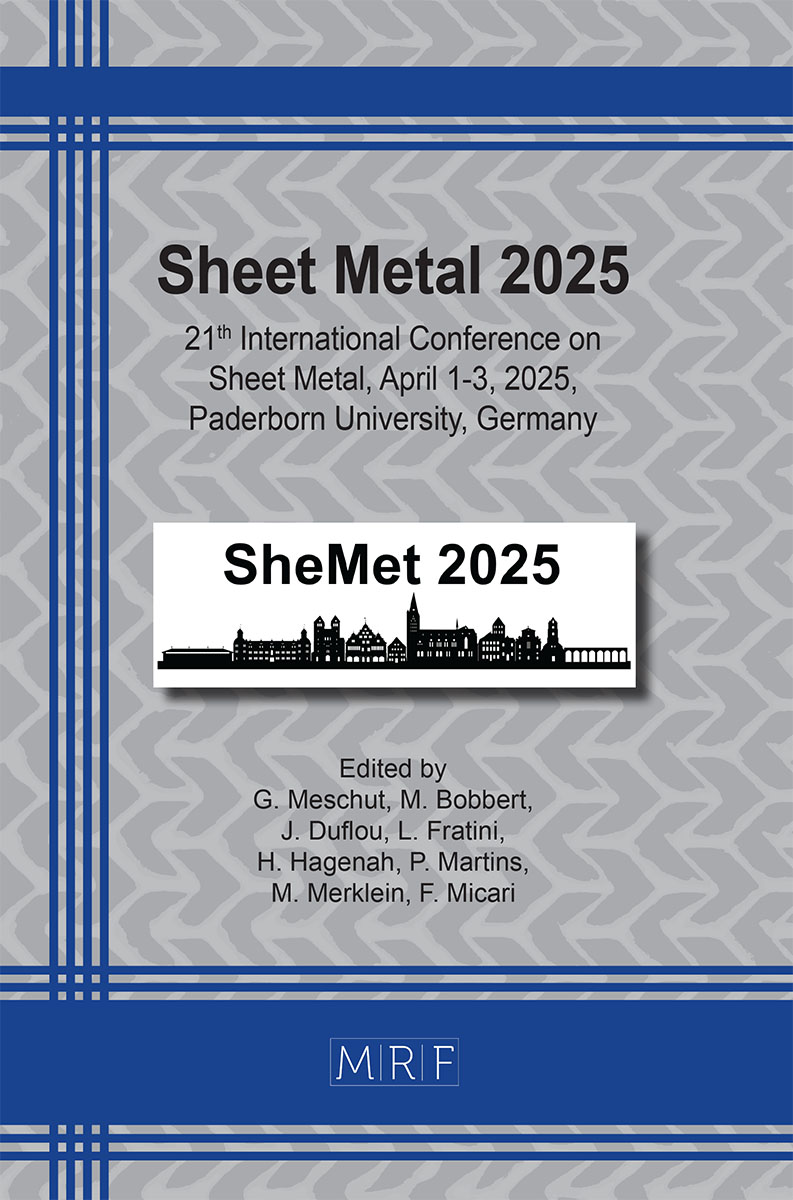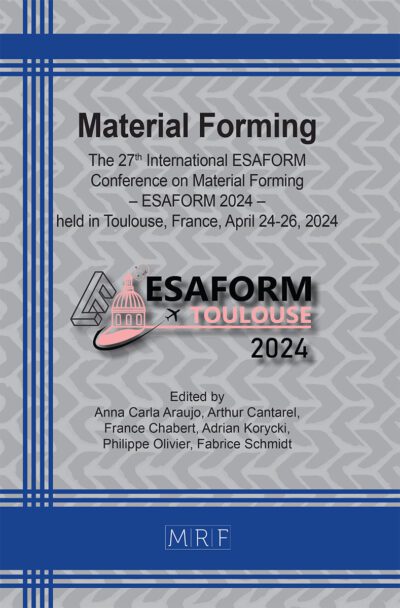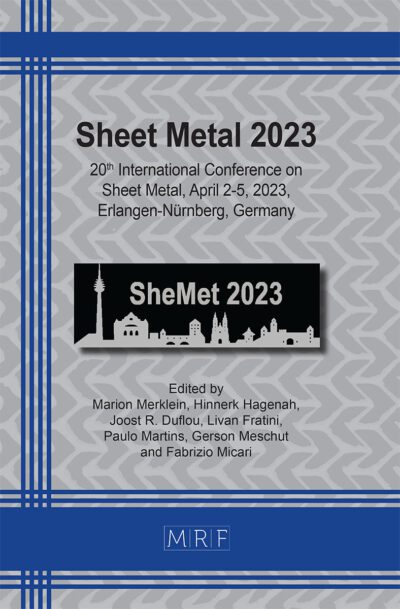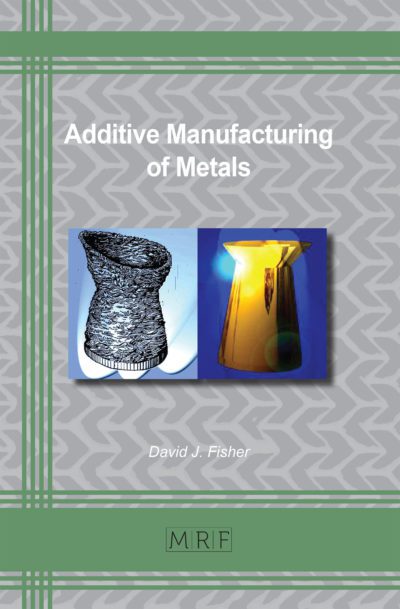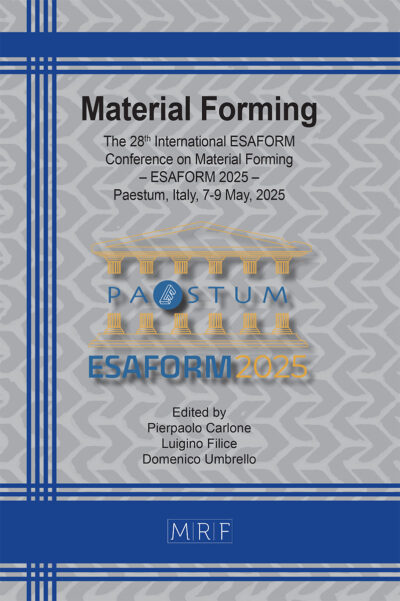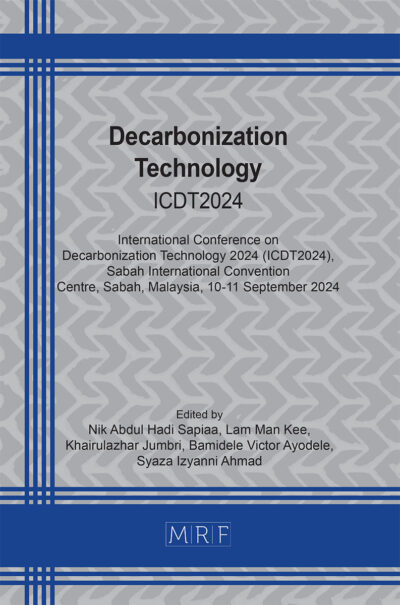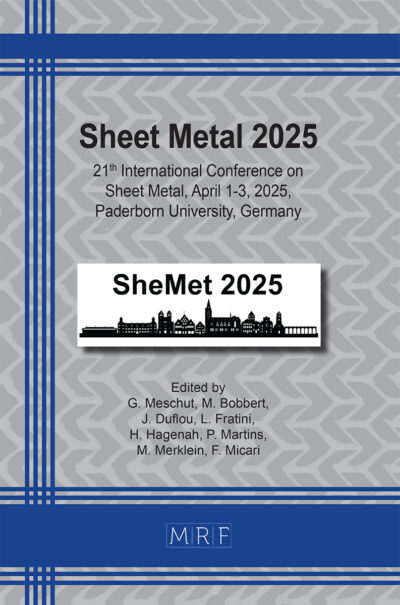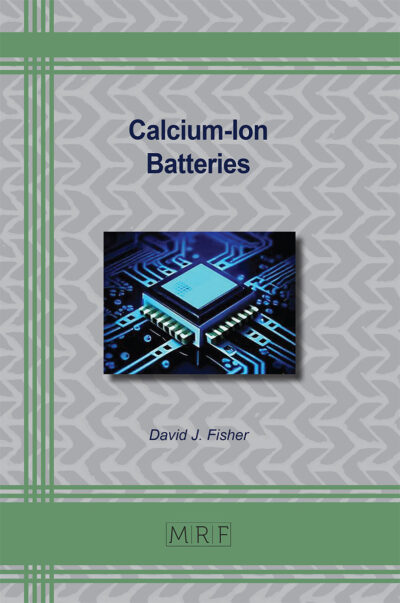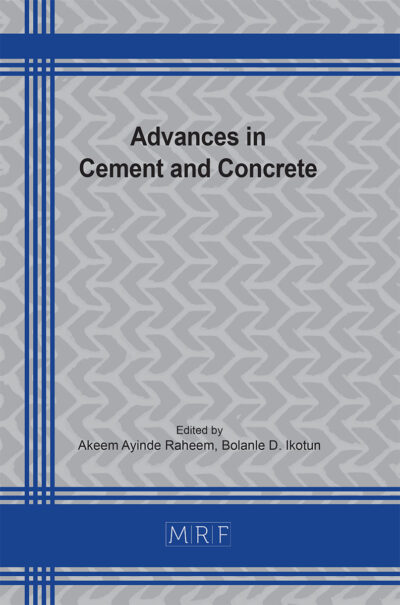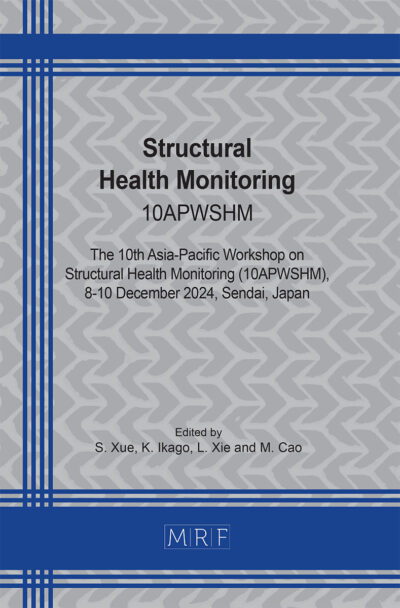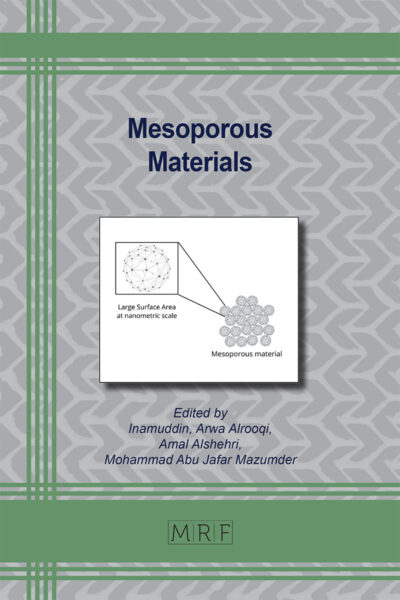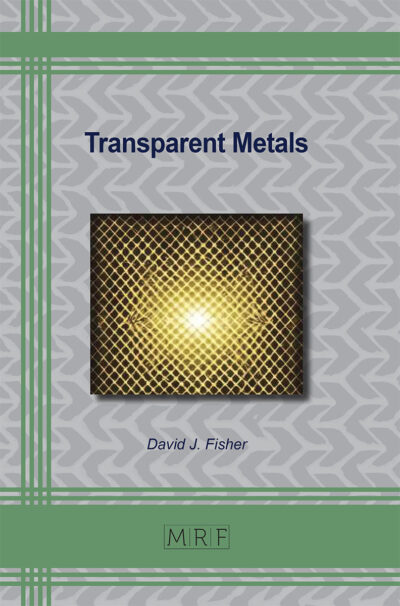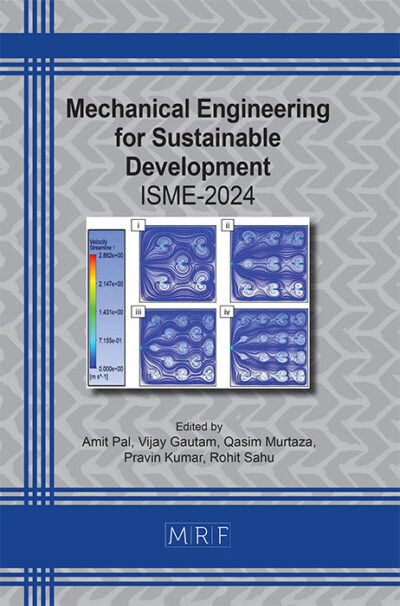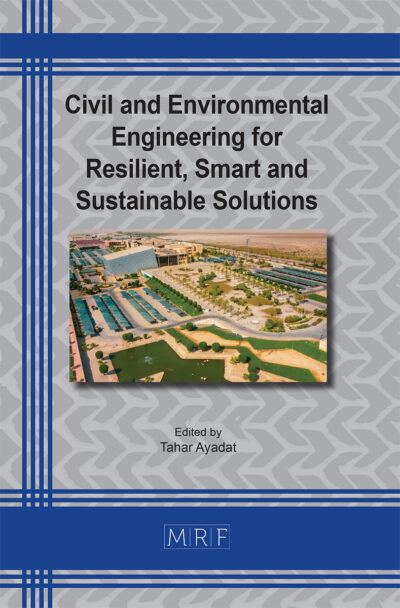Revisiting formability limits in incremental sheet forming
Margarida GRALHA, Bernardo COLAÇO, João P. MAGRINHO, Énio CHAMBEL, M. Beatriz SILVA
Abstract. The digital transition in manufacturing is driving significant advancements toward mass customization, enabling the production of tailored products at lower costs and shorter lead times. Single Point Incremental Forming (SPIF) is a promising technology in this context, offering the flexibility needed for producing complex, customized geometries without the need for dedicated tooling. Unlike conventional forming processes, SPIF relies on unique deformation mechanics that allow for higher formability, with the fracture forming line (FFL) as the process limit. This work revisits the analysis of formability limits in SPIF for aluminium sheets, revealing that fracture strains can occur beyond the FFL strain levels.
Keywords
Aluminium, Incremental Sheet Forming, Formability
Published online 4/1/2025, 8 pages
Copyright © 2025 by the author(s)
Published under license by Materials Research Forum LLC., Millersville PA, USA
Citation: Margarida GRALHA, Bernardo COLAÇO, João P. MAGRINHO, Énio CHAMBEL, M. Beatriz SILVA, Revisiting formability limits in incremental sheet forming, Materials Research Proceedings, Vol. 52, pp 59-66, 2025
DOI: https://doi.org/10.21741/9781644903551-8
The article was published as article 8 of the book Sheet Metal 2025
![]() Content from this work may be used under the terms of the Creative Commons Attribution 3.0 license. Any further distribution of this work must maintain attribution to the author(s) and the title of the work, journal citation and DOI.
Content from this work may be used under the terms of the Creative Commons Attribution 3.0 license. Any further distribution of this work must maintain attribution to the author(s) and the title of the work, journal citation and DOI.
References
[1] J. Jeswiet, F. Micari, G. Hirt, A. Bramley, J. Duflou, J. Alwood, Asymmetric single point incremental forming of sheet metal, CIRP Annals 54-2 (2005) 88-114. https://doi.org/10.1016/S0007-8506(07)60021-3
[2] J.R. Duflou, A.M. Habraken, AM., J. Cao, et al. Single point incremental forming: state-of-the-art and prospects. Int J Mater Form 11 (2018) 743-773. https://doi.org/10.1007/s12289-017-1387-y
[3] G. Hirt, S. Junk, N. Witulski, Incremental Sheet Forming: Quality Evaluation and Process Simulation, 7th ICTP International Conference on Technology of Plasticity, October 27-November 1, 2002, Yokohama, Japan, paper no. 343.
[4] W.C. Emmens, A.H. van den Boogaard, An overview of stabilizing deformation mechanisms in incremental sheet forming, J. Mater. Process. Technol. 209 (2009) 3688-3695. https://doi.org/10.1016/j.jmatprotec.2008.10.003
[5] R. Malhotra, L. Xue, T. Belytschko, J. Cao, Mechanics of fracture in single point incremental forming, J. Mater. Process. Technol. 212 (2012) 1573-1590. https://doi.org/10.1016/j.jmatprotec.2012.02.021
[6] M.B. Silva, M. Skjoedt, A.G. Atkins, N. Bay, P.A.F. Martins, Single-point incremental forming and formability-failure diagrams, J. Strain Analysis 43 (2008) 15-35. https://doi.org/10.1243/03093247JSA340
[7] J.D. Embury, J.L. Duncan, Formability maps, Annu. Rev. Mater. Res. 11 (1981) 505-521. https://doi.org/10.1146/annurev.ms.11.080181.002445
[8] ASTM E8/E8M-22 (2022) Standard test methods for tension testing of metallic materials.
[9] ISO 12004-2 (2021) Metallic materials-Sheet and strip-Determination of forming-limit curves-Part 2: Determination of forming-limit curves in the laboratory.
[10] A. Martínez-Donaire, F. García-Lomas, C. Vallellano, New approaches to detect the onset of localised necking in sheets under through-thickness strain gradients, Mater. Des. 57 (2014) 135-145. https://doi.org/10.1016/j.matdes.2014.01.012
[11] G. Centeno, A.J. Martínez-Donaire, D. Morales-Palma, C.Vallellano, M.B. Silva, P.A.F. Martins, Novel experimental techniques for the determination of the forming limits at necking and fracture, in: J.P. Davim (Ed.), Materials Forming and Machining, Woodhead Publishing, Amsterdam, 2015, pp. 1-24. https://doi.org/10.1016/B978-0-85709-483-4.00001-6
[12] T. McAnulty, J. Jeswiet, M. Doolan, Formability in single point incremental forming: A comparative analysis of the state of the art, CIRP-JMST 16 (2017) 43-45. https://doi.org/10.1016/j.cirpj.2016.07.003
[13] G. Centeno, A.J. Martínez-Donaire, C. Vallellano, L.H. Martínez-Palmeth, D. Morales, C. Suntaxi, F.J. García-Lomas, Experimental study on the evaluation of necking and fracture strains in sheet metal forming processes, Procedia Eng. 63 (2013) 650-658. https://doi.org/10.1016/j.proeng.2013.08.204
[14] G. Centeno, I. Bagudanch, A.J. Martínez-Donaire, M.L. García-Romeu, C. Vallellano, Critical analysis of necking and fracture limit strains and forming forces in single-point incremental forming, Mater. Des. 63 (2014) 20-29. https://doi.org/10.1016/j.matdes.2014.05.066
[15] S. Pandre, A. Morchhale, G. Mahalle, N. Kotkunde, K. Suresh, S.K. Singh, Fracture limit analysis of DP590 steel using single point incremental forming: experimental approach, theoretical modelling and microstructural evolution, ACME 21:95 (2021) 1-20. https://doi.org/10.1007/s43452-021-00243-1
[16] V.A.M. Cristino, M.B. Silva, P.K. Wong, P.A.F. Martins, Determining the fracture forming limits in sheet metal forming: A technical note, J. Strain Analysis 52-8 (2017) 467-471. https://doi.org/10.1177/0309324717727443
[17] M.B. Silva, P. Teixeira, A. Reis, P.A.F. Martins, On the formability of hole-flanging by incremental sheet forming, Proc. Inst. Mech. Eng. Part L 277-2 (2013) 91-99. https://doi.org/10.1177/1464420712474210
[18] K. Jawale, J.F. Duarte, A. Reis, M.B. Silva, Characterizing fracture forming limit and shear fracture forming limit for sheet metals, J. Mater. Process. Technol. 255 (2018) 886-897. https://doi.org/10.1016/j.jmatprotec.2018.01.035
[19] ASM Handbook. Volume 2, Properties and selection: Nonferrous alloys and special-purpose materials, Metals Park, Ohio, ASM International, 1990.

